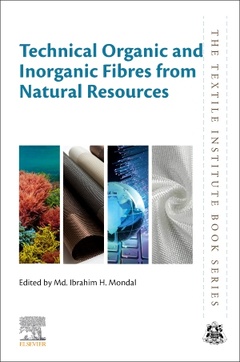Technical Organic and Inorganic Fibres from Natural Resources Woodhead Publishing in Materials Series
Langue : Anglais
Coordonnateur : Mondal Md. Ibrahim H.

Technical Organic and Inorganic Fibres from Natural Resources focuses on recent advances in the synthesis, processing, characterization, and application of non-textile fibers. The book provides a general introduction to the uses of natural fibers in technical textile applications while also reviewing the latest technical methods for producing these high-performance materials. As the textile industry is focused on finding alternative green fibers with the aim of providing high quality products which are fully recyclable and biodegradable, natural fibers from renewable sources play an increasingly important role in the industry due to their unique properties and functionality.
1. An overview of non-textile organic fibres
2. Cellulose nanofibres: Synthesis and applications
3. Chitin and chitosan fibres- Synthesis, structure and applications
4. Alginate fibres- Synthesis, structure and applications
5. Dietary fibres - Production, functions and benefits
6. Collagen fibres for biomedical applications
7. Hollow fibres and Hollow fibre membranes - Production, structure and applications
8. Nanofibres for medical textiles
9. Electrospun nanofibres for electronic devices and their applications
10. Cellulose-based composite fibres and applications
11. Introduction to inorganic fibres
12. Continuous inorganic fibres – Synthesis and applications
13. Carbon fibres and carbon nanofibres- Synthesis, structure and applications
14. Carbon nanotube fibres and yarns - Synthesis, structure and applications
15. Carbon nanotube for electronic textiles
16. Graphene fibre - Synthesis, structure and applications
17. Optical fibres and cables- Synthesis, structure and applications
18. Optical fibres for smart photonic textiles
19. Glass fibres- Production, structure and applications
20. Ceramic fibres- Production, structure and applications
21. Silicon-based optical fibres
22. Silicon carbide fibres- Production, structure and applications
23. Basalt fibres and their applications in automotive industry
24. Metal and metal-coated fibres
25. Asbestos fibres - adverse health and environmental effects and EPA regulations
26. Organic-inorganic hybrid composite fibres and applications
27. Application of ceramic matrix composites
28. Carbon fibre composites in marine applications
29. Glass fibre composites for aircraft and aerospace and others
30. Inorganic fibres and their impact on environment
2. Cellulose nanofibres: Synthesis and applications
3. Chitin and chitosan fibres- Synthesis, structure and applications
4. Alginate fibres- Synthesis, structure and applications
5. Dietary fibres - Production, functions and benefits
6. Collagen fibres for biomedical applications
7. Hollow fibres and Hollow fibre membranes - Production, structure and applications
8. Nanofibres for medical textiles
9. Electrospun nanofibres for electronic devices and their applications
10. Cellulose-based composite fibres and applications
11. Introduction to inorganic fibres
12. Continuous inorganic fibres – Synthesis and applications
13. Carbon fibres and carbon nanofibres- Synthesis, structure and applications
14. Carbon nanotube fibres and yarns - Synthesis, structure and applications
15. Carbon nanotube for electronic textiles
16. Graphene fibre - Synthesis, structure and applications
17. Optical fibres and cables- Synthesis, structure and applications
18. Optical fibres for smart photonic textiles
19. Glass fibres- Production, structure and applications
20. Ceramic fibres- Production, structure and applications
21. Silicon-based optical fibres
22. Silicon carbide fibres- Production, structure and applications
23. Basalt fibres and their applications in automotive industry
24. Metal and metal-coated fibres
25. Asbestos fibres - adverse health and environmental effects and EPA regulations
26. Organic-inorganic hybrid composite fibres and applications
27. Application of ceramic matrix composites
28. Carbon fibre composites in marine applications
29. Glass fibre composites for aircraft and aerospace and others
30. Inorganic fibres and their impact on environment
Md. Ibrahim H. Mondal is a Professor and Chairman in the Department of Applied Chemistry and Chemical Engineering at the University of Rajshahi, Bangladesh. He was a Commonwealth Visiting Scholar at the University of Manchester Institute of Science and Technology (UMIST) in the United Kingdom during 2003-04, a Visiting Professor at the Hokkaido University in Japan during 2006-07, and a Visiting Scientist at the Universiti Sains Malaysia, Malaysia during 2009-10. In 2018, he was awarded the UGC Gold Medal of the University Grants Commission of Bangladesh (UGC) by the President, and in 2020, he won the Dean's Award. Natural Fibres, Biofilms, Biopolymers, and Biocomposites, Cellulose & Derivatives, Superabsorbent Hydrogels, Biomaterials, Smart fibres, Nanomaterials in Textiles, Microbial Cellulose, Textile Modification, Functional Textiles, and Textiles-wet Processing are his research areas. He has over 170 research articles
and book chapters, as well as 13 books to his credit as an author, co-author, or editor.
and book chapters, as well as 13 books to his credit as an author, co-author, or editor.
- Covers the full range of fibers from natural sources, including organic materials like chitosan as well as inorganic ones like carbon nanofibers
- Includes an overview of EPA regulations on hazardous natural fibers
- Industry case studies are provided throughout to explain production methods and applications
Date de parution : 12-2024
Ouvrage de 662 p.
15x22.8 cm
Thèmes de Technical Organic and Inorganic Fibres from Natural... :
© 2024 LAVOISIER S.A.S.



